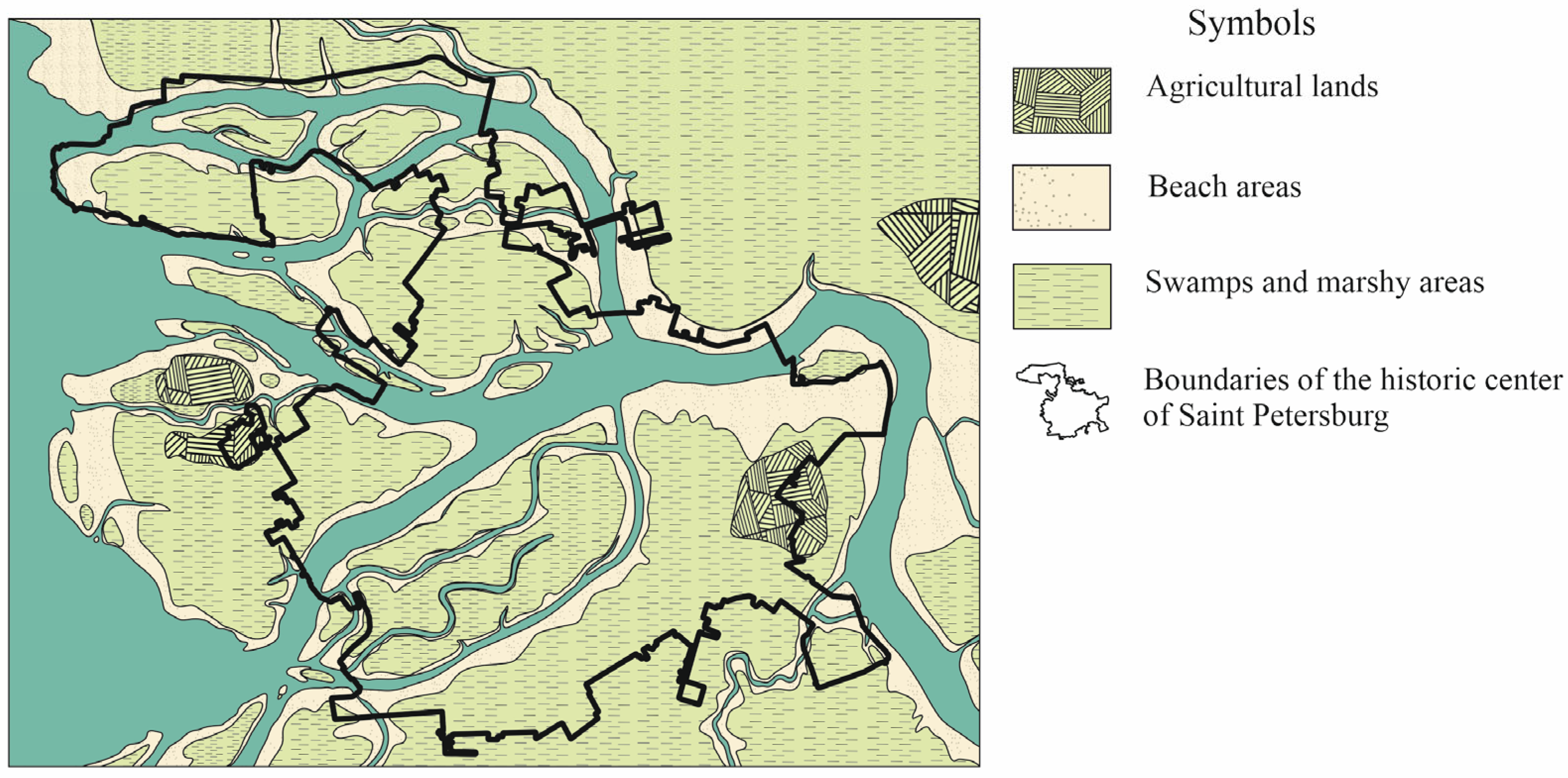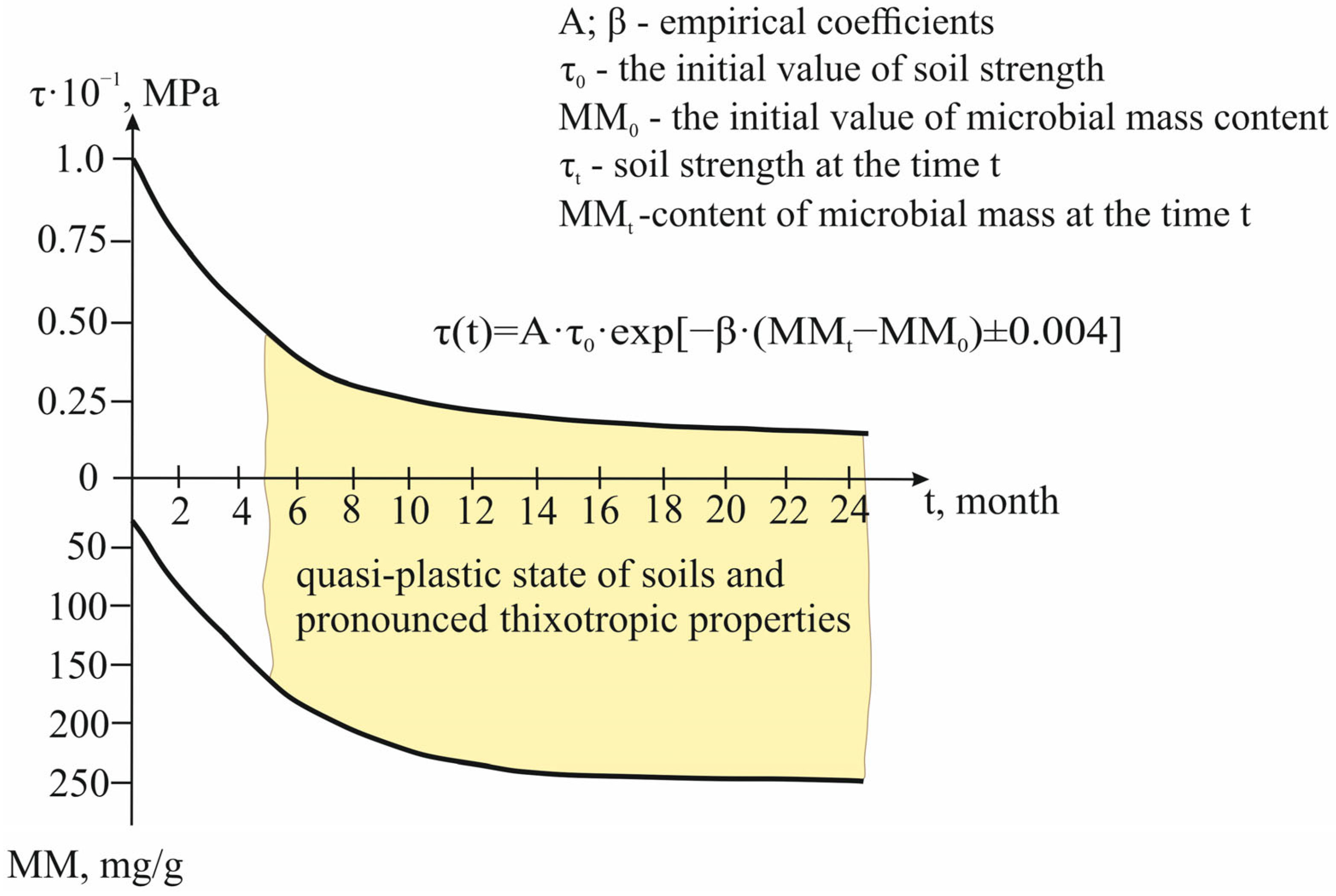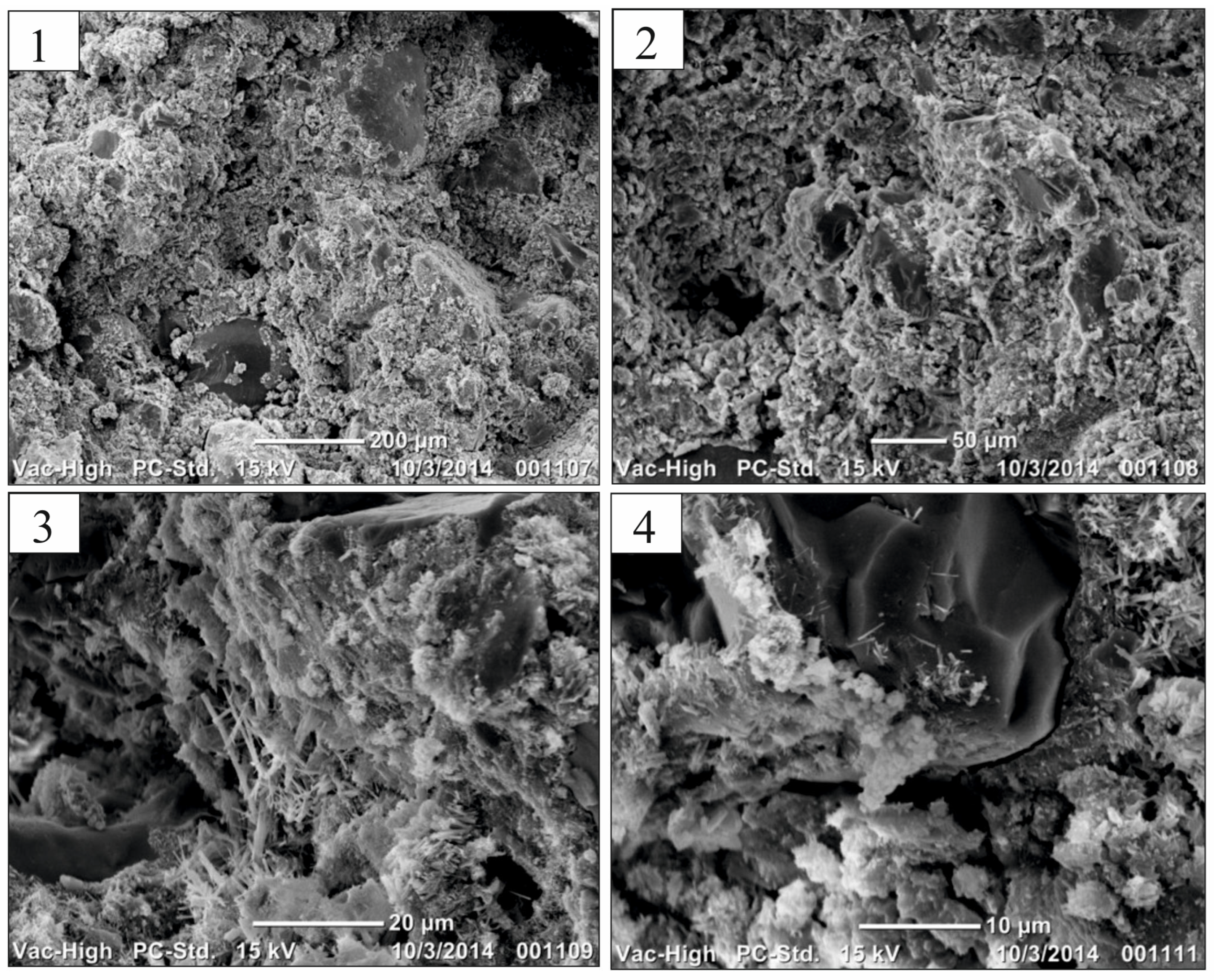Scientific-Practical Enhancement Principles for the Long-Term Stability of Cultural Heritage Objects through a Multi-Component Underground Space Analysis
Abstract
1. Introduction
2. Methodology, Methods, and Materials for Engineering-Geological and Geotechnical Research
- -
- underground water.
- -
- microorganisms.
- -
- gases of various geneses, solubilities, and aggressiveness.
- -
- underground bearing and enclosing structures of buildings and constructions, which have complex interactions with the aforementioned components.
3. Results
3.1. Results of Underground Space Research at the Regional Level
3.2. Results of Underground Space Research at the Local Level
4. Discussion
4.1. Discussion of Engineering-Geological and Geotechnical Research Results on Underground Space at the Object Level
4.2. Recommendations for Conducting Field and Laboratory Research in the Foundation Zone of Cultural Heritage Objects
4.3. Some Examples of the Methodology’s Application in Saint Petersburg and Abroad
Author Contributions
Funding
Data Availability Statement
Acknowledgments
Conflicts of Interest
References
- Viggiani, C. Cultural heritage and geotechnical engineering: An introduction. In Proceedings of the 2nd International Symposium on Geotechnical Engineering for the Preservation of Monuments and Historic Sites, Napoli, Italy, 30–31 May 2013; p. 12. [Google Scholar]
- Burland, J.B.; Jamiolkowski, M.B.; Squeglia, N.; Viggiani, C. The Tower of Pisa: History, Construction and Geotechnical Stabilization; CRC Press: London, UK, 2020; p. 62. [Google Scholar] [CrossRef]
- Hemeda, S.; Sonbol, A. Sustainability problems of the Giza pyramids. Herit. Sci. 2020, 8, 8. [Google Scholar] [CrossRef]
- Hemeda, S. PLAXIS 3D numerical analysis of complex geotechnical problems of colossal built heritage. Herit. Sci. 2024, 12, 32. [Google Scholar] [CrossRef]
- Coli, M.; Iwasaki, Y. Novel approaches and technologies for heritage buildings conservation: Editorial. Appl. Sci. 2021, 11, 10597. [Google Scholar] [CrossRef]
- Iwasaki, Y.; Fukuda, M.; Ishizuka, M.; McCarthy, R.; Akazawa, Y.; Nakagawa, T.; Ly, V. The authenticity and the integrity of the soil and the foundation of heritage structure of Bayon Temple, Angkor. In Geotechnical Engineering for the Preservation of Monuments and Historic Sites III; Lancellotta, R., Viggiani, C., Flora, A., de Silva, F., Mele, L., Eds.; CRC Press: London, UK, 2022; pp. 325–336. [Google Scholar] [CrossRef]
- Nikitin, N.P. Auguste Montferrand: Design and Construction of Saint Isaac’s Cathedral and the Alexander Column; Leningradskoe otdelenie Soyuza Sovetskix Arxitektorov: Saint Petersburg, Russia, 1939; p. 348. (In Russian) [Google Scholar]
- Shashkin, A.G.; Shashkin, V.A. Is it possible to preserve historical monuments on the basis of standards for new construction? Geotechnics 2021, 13, 20–30. (In Russian) [Google Scholar] [CrossRef]
- Shashkin, A.G.; Shashkin, V.A.; Bogov, S.G.; Voronov, A.S. Waterproofing of architectural monuments. Geotechnics 2022, 14, 28–41. (In Russian) [Google Scholar] [CrossRef]
- Ulitsky, V.M.; Shashkin, A.G. Preservation of architectural monuments and provision of their mechanical safety. Ind. Civ. Eng. 2017, 7, 31–39. (In Russian) [Google Scholar]
- Sotnikov, S.N. The settlement of Saint Isaac’s Cathedral in Leningrad. In Foundation Construction in Conditions of Weak and Frozen Soils: Inter-University Thematic Collection of Papers; Dalmatov, B.I., Ed.; LISI [Leningrad Civil Engineering Institute]: Saint Petersburg, Russia, 1986; pp. 7–18. (In Russian) [Google Scholar]
- Mangushev, R.A.; Osokin, A.I.; Sotnikov, S.N. Geotechnics of St. Petersburg. Experience in Construction on Weak Soils; ACB: Moscow, Russia, 2018; p. 386. (In Russian) [Google Scholar]
- Pashkin, E.M. Engineering-Geological Diagnostics of Deformations of Architectural Monuments; ANO «Tradiciya»: Moscow, Russia, 2022; p. 368. (In Russian) [Google Scholar]
- Pashkin, E.M. Lift and moving of architectural monuments as the main methods of their preservation. Geotechnics 2022, 14, 18–26. (In Russian) [Google Scholar] [CrossRef]
- Protosenya, A.G.; Alekseev, A.V.; Verbilo, P.E. Prediction of the stress-strain state and stability of tunnel face at the intersection of disturbed zones of the soil mass. J. Min. Inst. 2022, 254, 252–260. [Google Scholar] [CrossRef]
- Dashko, R.E.; Lokhmatikov, G.A. The Upper Kotlin clays of the Saint Petersburg region as a foundation and medium for unique facilities: An engineering-geological and geotechnical analysis. J. Min. Inst. 2022, 254, 180–190. [Google Scholar] [CrossRef]
- Dashko, R.E. Engineering-Geological Analysis and Assessment of Water-Saturated Clayey Rocks as Foundation for Structures; Publishing house of the Institute “Georekonstrukciya”: Saint Petersburg, Russia, 2015; p. 384. (In Russian) [Google Scholar]
- Dashko, R.E.; Aleksandrova, O.Y.; Kotukov, P.V.; Shidlovskaya, A.V. Special aspects of geotechnical conditions of St. Petersburg. Urban. Dev. Geotech. Constr. 2011, 1, 1–47. (In Russian) [Google Scholar]
- Loseva, E.; Osokin, A.; Mironov, D.; Dyakonov, I. Specific features of the construction and quality control of pile foundations in engineering and geological conditions of Saint Petersburg. Archit. Eng. 2020, 5, 38–45. [Google Scholar] [CrossRef]
- Dashko, R.E.; Vlasov, D.Y.; Shidlovskaya, A.V. Geotechnics and Subsurface Microbiota; Publishing House of the Institute “Georekonstrukciya”: Saint Petersburg, Russia, 2014; p. 279. (In Russian) [Google Scholar]
- Ridus. Available online: https://www.ridus.ru/v-sankt-peterburge-uchastilis-avarii-v-kanalizacii-399141.html (accessed on 10 August 2024).
- Guo, B.; Liu, C.; Gibson, C.; Frigon, D. Wastewater microbial community structure and functional traits change over short timescales. Sci. Total Environ. 2019, 662, 779–785. [Google Scholar] [CrossRef]
- LaMartina, E.L.; Mohaimani, A.A.; Newton, R.J. Urban wastewater bacterial communities assemble into seasonal steady states. Microbiome 2021, 9, 116. [Google Scholar] [CrossRef]
- Polovnilov, V.Y.; Volynin, A.F. Geophysical and thermal analysis of soils in the zones of location of sewer collectors in St. Petersburg. Bull. Tomsk Polytech. Univ. Geo Assets Eng. 2022, 333, 81–88. (In Russian) [Google Scholar] [CrossRef]
- David Rumsey Map Collection. Available online: https://www.davidrumsey.com/luna/servlet/detail/RUMSEY~8~1~2289~180029:Sanitary-&-Topographical-Map-of-the (accessed on 10 August 2024).
- Maksomovich, N.G.; Demenev, A.D.; Khmurchik, V.T. Transformation of the Mineral Composition of Dispersed Soil under Microbiological Impact. Bull. Perm Univ. Geol. 2021, 20, 24–32. (In Russian) [Google Scholar] [CrossRef]
- Lebedeva, Y.; Kotiukov, P.; Lange, I. Study of the Geo-Ecological State of Groundwater of Metropolitan Areas under the Conditions of Intensive Contamination Thereof. J. Ecol. Eng. 2020, 21, 157–165. [Google Scholar] [CrossRef]
- Kobak, A.V.; Piryutko, Y.M. Historical cemeteries of Saint Petersburg; Center-Polygraph: Moscow, Russia, 2009; p. 797. (In Russian) [Google Scholar]
- Gorskaya, V.A. Engineering-Geological Analysis of the Historical Aspect of the Development and Contamination of the Underground Space of Saint Petersburg. Ph.D. Thesis, Saint Petersburg Mining University, Saint Petersburg, Russia, 2017. Available online: https://spmi.ru/sites/default/files/imci_images/sciens/dissertacii/2018/avtoreferat_gorskaya.pdf (accessed on 12 August 2024). (In Russian).
- Zareczkij, Y.K. Soil Consolidation Theory; Nauka: Moscow, Russia, 1967; p. 270. (In Russian) [Google Scholar]
- Pereiro, I.; Fomitcheva Khartchenko, A.; Petrini, L.; Kaigala, G.V. Nip the bubble in the bud: A guide to avoid gas nucleation in microfluidics. Lab Chip 2019, 19, 2296–2314. [Google Scholar] [CrossRef]
- Nadson, G.A. The Problem of Microbial Variability, Its Theoretical and Practical Significance; Selkhozgiz: Moscow, Russia, 1931; p. 36. (In Russian) [Google Scholar]
- Lee, K.-Y.; Park, S.-Y.; Kim, C.-G. Effects of radon on soil microbial community and their growth. Environ. Eng. Res. 2020, 25, 29–35. [Google Scholar] [CrossRef]
- Narenkumar, J.; AlSalhi, M.S.; Prakash, A.A.; Abilaji, S.; Devanesan, S.; Rajasekar, A.; Alfuraydi, A.A. Impact and Role of Bacterial Communities on Biocorrosion of Metals Used in the Processing Industry. ACS Omega 2019, 4, 21353–21360. [Google Scholar] [CrossRef]
- Little, B.J.; Blackwood, D.J.; Hinks, J.; Lauro, F.M.; Okamoto, A.; Rice, S.A.; Wade, S.A.; Flemming, H.C. Microbially influenced corrosion—Any progress? Corros. Sci. 2020, 170, 108641. [Google Scholar] [CrossRef]
- Dashko, R.E.; Alekseev, I.V. On the issue of the role of the biocorrosion processes in the underground environment of megapolises. Eng. Geol. World 2016, 1, 22–29. (In Russian) [Google Scholar]
- Duhanina, U.N. Influence of bacterial microorganisms on the development of concrete biocorrosion. Vestn. Nauk. 2023, 5, 472–476. (In Russian) [Google Scholar]
- Cytovich, N.A.; Zareczkij, Y.K.; Maly’shev, M.V.; Abelev, M.Y.; Ter-Martirosyan, Z.G. Forecasting the Settlement Rate of Building Foundations: Consolidation and Creep of Multiphase Soils; Strojizdat: Moscow, Russia, 1967; p. 236. (In Russian) [Google Scholar]
- Abelev, M.Y. Weak Water-Saturated Clayey Soils as Building Foundations; Strojizdat: Moscow, Russia, 1973; p. 288. (In Russian) [Google Scholar]
- Trushko, O.V.; Trushko, V.L.; Demenkov, P.A. Arrangement of multistory underground parking garages in complex engineering and geological environment. Int. J. Math. Eng. Manag. Sci. 2020, 5, 897–912. [Google Scholar] [CrossRef]
- Demenkov, P.A.; Goldobina, L.A.; Trushko, O.V. Geotechnical barrier options with changed geometric parameters. Int. J. GEOMATE 2020, 19, 58–65. [Google Scholar] [CrossRef]
- Dashko, R.E.; Gorskaya, V.A. Multifactor assessment of the causes progressive destruction of the New Hermitage buildings. Ind. Civ. Eng. 2015, 11, 8–14. (In Russian) [Google Scholar]
- Dashko, R.E.; Salnikov, P.M. Main principles of an integral monitoring for St. Isaac’s Cathedral in Saint-Petersburg. In Proceedings of the International Forum-Contest of Young Researchers Topical Issues of Rational Use of Natural Resources, Saint Petersburg, Russia, 18–20 April 2018; pp. 17–22. [Google Scholar]
- Dashko, R.E.; Karpenko, A.G. Current state of above-ground and underground structures of the Alexander Column: An integral basis for its stability. J. Min. Inst. 2023, 263, 757–773. [Google Scholar]
- Choker, H.M.; Mustafin, M.G. Geodesic support of laser scan technology use for fixing cultural heritage objects. Geod. Cartogr. 2021, 82, 2–10. (In Russian) [Google Scholar] [CrossRef]
- Hatoum, H.M.; Mustafin, M.G. Optimization of locating robotic total stations for determining the deformations of buildings and structures. Geod. Cartogr. 2020, 963, 2–13. (In Russian) [Google Scholar] [CrossRef]
- Glazunov, V.V.; Ageev, A.S.; Gorelik, G.D.; Sarapulkina, T.V. Results of Comprehensive Geophysical Studies on the Search for Crypts on the Territory of Suburban Necropolis of Tauric Chersonese in the Karantinnaya Balka. J. Min. Inst. 2021, 247, 12–19. [Google Scholar] [CrossRef]
- Dashko, R.E.; Nguyen, T.C. Engineering and geological substantiation of the concept and structure of complex monitoring of some architectural and historical monuments in Hanoi. Int. Res. J. 2017, 4, 57–65. (In Russian) [Google Scholar] [CrossRef]
- Dashko, R.E.; Alekseev, I.V. Microbially-Induced Corrosion of Structural Materials in Underground Workings of the Yakovlev’s Mine (Kursk Magnetic Anomaly, Russia). Biosci. Biotechnol. Res. Asia 2017, 14, 167–175. [Google Scholar] [CrossRef]
- Dashko, R.E.; Romanov, I.S. Forecasting of mining and geological processes based on the analysis of the underground space of the Kupol deposit as a multicomponent system (Chukotka Autonomous Region, Anadyr district). J. Min. Inst. 2021, 247, 20–32. [Google Scholar] [CrossRef]
- Dashko, R.E.; Vlasov, D.Y.; Romanov, I.S. Some Case Studies of Mine Support Biocorrosion in Underground Workings in Various Climatic Zones. Russ. Met. 2023, 2023, 2000–2004. [Google Scholar] [CrossRef]










| Analysis Elements | Element Content, mg/dm3 |
|---|---|
| Ca2+ | 53.0 |
| Mg2+ | 21.0 |
| Na + K | 378.0 |
| SO42− | 123.0 |
| Cl− | 420.0 |
| HCO3− | 488.0 |
| Mineralization | 1344.0 |
| Analysis Elements | Element Content, mg/dm3 | ||
|---|---|---|---|
| Alexander Nevsky Lavra | Commandant’s Cemetery in the Petropavlovskaya Fortress | * Park Zone (Beyond Zones of Technogenic Contamination of the Subsurface Environment) | |
| Ca2+ | 150.0 | 100.0 | 4.0–41.0 |
| Mg2+ | 116.4 | 66.0 | 5.0–17.0 |
| Na + K | 7.09 | 1.89 | 2.5–66.0 |
| NH4+ | 123.0 | 2.9 | 1.2–3.7 |
| SO42− | 176.0 | 2.0 | 18.0–80.0 |
| Cl− | 40.0 | 30.0 | 5.0–28.0 |
| HCO3− | 1189.5 | 396.5 | 79.0–189.0 |
| NO3− | 1.2 | 0.9 | 1.1–7.5 |
| Mineralization | 1804.6 | 604.1 | 170.0–285.0 |
| CO2 (aggressive) | 59.4 | 19.8 | 132.0–190.0 |
| PO 1, mgO2/dm3 | 35.2 | 16.0 | 6.0–30.0 |
| COD 2, mgO2/dm3 | 310.4 | 46.6 | Was not determined |
| BOD5 3, mgO2/dm3 | 27.2 | 2.8 | 1.5–6.0 |
| pH (in situ) | 6.9 | 7.4 | 5.3–6.8 |
| Eh, mV (in situ) | −108.0 | −12.5 | Was not determined |
| Analysis Elements | Element Content, mg/dm3 | ||
|---|---|---|---|
| * Apraksin Dvor (Operated 1754–1860s) | ** Formerly Horse Market, Operated for over 180 Years Until the End of the 19th Century) | *** Park Zone (Beyond Zones of Technogenic Contamination of the Subsurface Environment) | |
| Ca2+ | 128.0–169.0 | 132.0 | 4.0–41.0 |
| Mg2+ | 37.7–158.0 | 108.2 | 5.0–17.0 |
| Na + K | 51.1–170.0 | 442.1 | 2.5–66.0 |
| NH4+ | 0.6–4.0 | - | 1.2–3.7 |
| SO42− | 81.5–240.0 | 110.2 | 18.0–80.0 |
| Cl− | 80.0–156.0 | 451.6 | 5.0–28.0 |
| HCO3− | 466.7–1135.0 | 1232.2 | 79.0–189.0 |
| NO3− | 0.2–24.0 | 8.1 | 1.1–7.5 |
| Mineralization | 854.1–2043.3 | 2500.0 | 170.0–285.0 |
| CO2 (aggressive) | 16.5 | - | 0.0–33.0 |
| PO 1, mgO2/dm3 | 27.0–32.0 | 36.8 | 6.0–30.0 |
| pH | 7.5 | 7.0 | 5.3–6.8 |
| Eh, mV (in situ) | Was not determined | −127.0 | Was not determined |
Disclaimer/Publisher’s Note: The statements, opinions and data contained in all publications are solely those of the individual author(s) and contributor(s) and not of MDPI and/or the editor(s). MDPI and/or the editor(s) disclaim responsibility for any injury to people or property resulting from any ideas, methods, instructions or products referred to in the content. |
© 2024 by the authors. Licensee MDPI, Basel, Switzerland. This article is an open access article distributed under the terms and conditions of the Creative Commons Attribution (CC BY) license (https://creativecommons.org/licenses/by/4.0/).
Share and Cite
Dashko, R.E.; Karpenko, A.G. Scientific-Practical Enhancement Principles for the Long-Term Stability of Cultural Heritage Objects through a Multi-Component Underground Space Analysis. Heritage 2024, 7, 4455-4471. https://doi.org/10.3390/heritage7080210
Dashko RE, Karpenko AG. Scientific-Practical Enhancement Principles for the Long-Term Stability of Cultural Heritage Objects through a Multi-Component Underground Space Analysis. Heritage. 2024; 7(8):4455-4471. https://doi.org/10.3390/heritage7080210
Chicago/Turabian StyleDashko, Regina E., and Angelina G. Karpenko. 2024. "Scientific-Practical Enhancement Principles for the Long-Term Stability of Cultural Heritage Objects through a Multi-Component Underground Space Analysis" Heritage 7, no. 8: 4455-4471. https://doi.org/10.3390/heritage7080210
APA StyleDashko, R. E., & Karpenko, A. G. (2024). Scientific-Practical Enhancement Principles for the Long-Term Stability of Cultural Heritage Objects through a Multi-Component Underground Space Analysis. Heritage, 7(8), 4455-4471. https://doi.org/10.3390/heritage7080210






